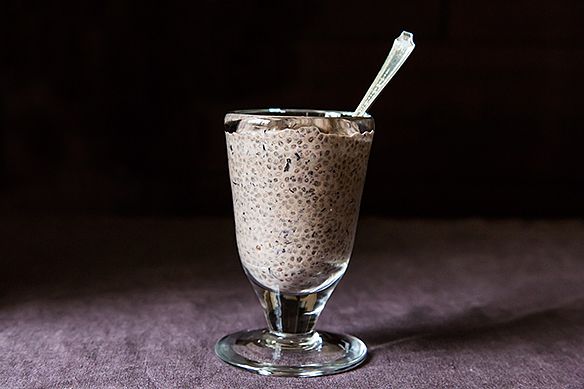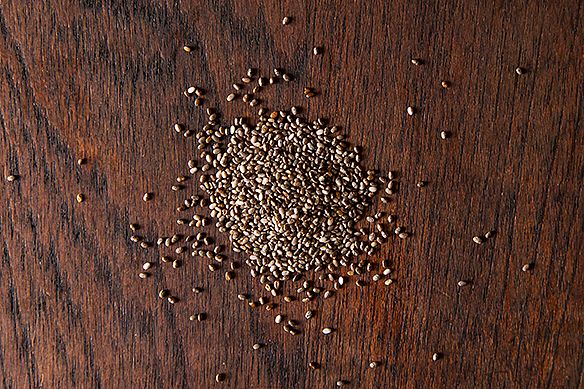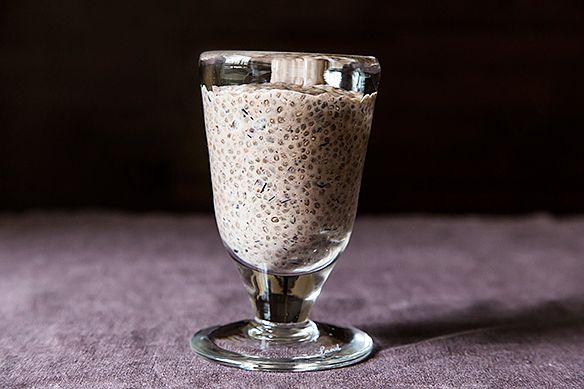Gena Hamshaw of the blog Choosing Raw eats a mostly raw, vegan diet without losing time, money, or her sanity. Let her show you how to make "rabbit food" taste delicious and satisfying every other Thursday on FOOD52.
Today: It's so much more than just a plant -- Gena introduces us to ch-ch-ch-chia seeds with a recipe for Blueberry Cardamom Chia Pudding.

“Do they make your hair grow?”
I’ve just been talking to a friend about chia seeds, and I’m not surprised when a reference to the famous chia pet comes up. (Ch-ch-ch-chia!) My friend is amused when I tell him that, in fact, the chia seeds I love to eat and the chia seeds used on chia pet planters are one and the same.
“Wow,” he says. “You eat those?”
Believe it or not, I do. Chia seeds are one of my favorite foods; I use them in baked goods, in smoothies, and, most often, in puddings. And I’m not the only one. These small, dark seeds are darlings of the nutrition world right now. While I can’t promise you that they’ll make your hair grow, I can assure you that the current chia craze is legit: chia seeds are nutritionally rich, handy in all sorts of food preparation methods, and, if you know what to do with them, very delicious.
At this point, you’ve probably seen Salvia hispanica at a specialty grocery store, a Whole Foods, or in a magazine. If you didn’t, you might have come across them in the book Born to Run. In it, we learn that the Tarahumara people, who are renowned for their superhuman endurance as distance runners, have been making “chia fresca” drinks (think lemonade pudding--weird, but not in a bad way) for ages.
Why? It may be because chia seeds, like tapioca pearls, absorb liquid, and can therefore be hydrating (and soothing to digestion.) They’re very high in Omega-3 fatty acids, which are increasingly being shown to have a positive impact on cardiovascular health and to play a role in controlling inflammation. On top of all of that, they’re a great source of plant-based calcium, and a good source of protein, which means that vegans, vegetarians, and folks who are just trying to reduce their meat consumption are especially fond of them.
That’s the good news. The bad news is that chia seeds have a slight learning curve. If you just want to sprinkle them on top of some breakfast cereal, oats, or stir them into muffins or banana bread, great: unlike flax seeds, you don’t have to chew chia seeds to get all of the nutritional benefits, and you’ll probably find that they lend a pleasant crunch and texture to your food. That said, this is a pretty boring way to experience chia, if only because the coolest feature of chia seeds is that they plump up in liquid.

For this reason, the most popular way to enjoy chia seeds is in a chia pudding. For vegans, this usually means soaking chia seeds in a non-dairy milk, and using whatever add-ins (spices, fruit, cocoa) are desired. Chia pudding is totally hands off (you quite literally just have to soak the seeds, then stir them as they plump up), a quick and easy breakfast option, and delicious with fresh fruit. The only downside to be aware of is that different chia seeds absorb different amounts of liquid, so it can be a little tough to predict how much liquid you need for a pudding recipe. The most common complaint about chia pudding is that it turned out too runny or too pasty.
To avoid this, you simply have to use a little kitchen intuition. The desired texture for a chia pudding is something that resembles tapioca pudding; just imagine that the tapioca pearls are tinier and more fine than the usual. You should be able to spoon or pour the pudding; you just don’t want it to get soupy. So, if you soak your pudding overnight and find that it’s too thick, simply add more milk (I usually add in quarter-cup increments) till it’s the right texture. If, on the other hand, your pudding is way too runny, just add two tablespoons of chia (and more as needed) till it looks right.
Once you get the process down, you’ll find that chia puddings are one of the most versatile and tasty delights of the vegan food world. I’ve served chia pudding up to total skeptics (both ladies and gents), only to hear about how delighted they were with the results. As a full time student, I rely on chia pudding for easy, portable breakfasts: before I go to bed, I combine three tablespoons of chia with a scant cup of almond milk, some cinnamon, and a bit of maple syrup, then let it soak in the fridge overnight. In the morning, I pack it up and take it to campus, where I pick up a banana or berries to mix in. It’s a wonderful meal, and adds plenty of brightness to the pain of morning classes!
If that sounds a little boring to you, consider the following recipe, which showcases just how creative chia pudding can get. I’ve made countless chia pudding flavor combinations (you can find a good roundup here), including chocolate, pumpkin, and strawberry ginger. But this pudding, which features the surprisingly winning flavor combination of blueberry and cardamom, is a new all-time favorite. Sweet, spicy, and totally unexpected, this is a very unique and visually stunning way to enjoy chia seeds. Serve it with fresh blueberries and a little shaved coconut for breakfast, or enjoy a few spoonfuls for a light, healthy dessert. Whether your hair grows faster or not, you’ll be glad you tried it!

Blueberry Cardamom Chia Pudding
Serves 4-6
1/2 cup chia seeds
2 1/2 cups almond milk (or rice, soy, or light coconut milk)
1 cup fresh blueberries
1 1/2 tsp cardamom
1 tsp cinnamon
1/4 cup maple syrup or agave nectar
1 tsp vanilla extract
See the full recipe (and save and print it) here.





See what other Food52 readers are saying.